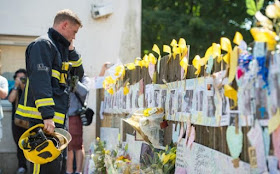 |
| Grenfell Tower fire London, England dezeen.com |
The terrifying scenes of a 24 Grenfell Tower in London went up in fast moving flames on Wednesday, June 14, 2017. The public housing tower was home to about 600 people in the city's West end. Thus far, the death toll has risen to 79 people with the possibility of more. Exacerbating the recovery process are concerns over the stability of the building's hulking remains. Truly terrifying to conceive of.
Feargus O'Sullivan writes, in his CityLab article "Did London's Housing Crisis Help Spark a Fatal Blaze?" "As the tower continues to smolder, a truly awful story is coming into focus. It's not just the grim news that people have died and hundreds more are suddenly homeless. It's also that tenants of Grenfell Tower have been warning of unsafe conditions for years."
 |
| Police cordon at the Grenfell Tower Fire London, England nytimes.com |
It is a truly terrifying thought but the Grenfell Action Group firmly believe that only a catastrophic event will expose the ineptitude and incompetence of our landlord...and bring an end to the dangerous living conditions and neglect of health and safety legislation that they inflict upon their tenants and leaseholders. (grenfellactiongroup.wordpress.com; November 2016; date accessed June 19, 2017)
 |
| Remains of the Grenfell Tower bbc.co.uk |
 |
| Grenfell Tower Fire Action Plan thesun.co.uk |
However, in the very next paragraph of Mr. Kirkpatrick's article, "But experts on British fire safety rules that the material, used as exterior cladding, in fact complied with regulations. Other countries, including the United States, have placed stricter restrictions on how such materials can be used, but Britain had not done so, they said." (Ibid)
The alarm system was also functional, albeit on a floor-by-floor basis, and even more strange, residents were instructed that "if a fire occurred, they should remain in their homes."
 |
| Firefighter reviewing Grenfell Tower Fire victim tributes telegraph.co.uk |
Even more unfathomable, is the official response to the persist, well-documented complaints from the tenants. Residents began posting protests about KCTMO on the resident association blog, prompting the management company's lawyers to send letters demanding the post be removed. A BBC interview with residents makes very clear that the tenants were either ignored or threatened by contractors when they voiced their concerns. (http://www.bbc.com; date accessed June 19, 2017)
Those unheeded protests have left residents homeless and a growing casualty list.
 |
| Grenfell Tower in flames kpax.com |
"The spectacular nature of the fire may be a one-off, but the conditions that made it possible are not. A 2011 report, published in The Guardian, titled "Social housing blocks 'unsafe in fire,'" Peter Walker wrote,
"Three-quarters of all social housing blocks are potentially unsafe in a fire, according to a survey questioning managers responsible for ensuring buildings are properly maintained." (http://www.theguardian.com; July 18, 2011; date accessed June 19, 2017)
The situation was made worse when many former publicly owned units were placed in the private market, as part of a Right to Buy plan. "This allowed long-term public housing tenants to buy their apartments at a discount, and many quickly re-sold at a mark-up soon after. As a result, the most desirable projects ended up in part-private ownership."
There is an obvious political element: "In recent years, the state and availability of public housing has been one of the hotly contested issues in Britain-especially in London."
This is London's current white hot issue-the chronic housing shortage. Feargus O'Sullivan describes the city: "Most of London is built at fairly low densities, but planning laws and organized resistance by suburbanites have made it very difficult to build enough new housing in the more spacious out boroughs." By comparison, inner-city building projects are fairly easy to redevelop because the site is publicly owned. These sites have been specifically targeted for densification projects, rebuilding, and in-fill construction.
 |
| Man presumed dead in the fire is brought to safety and alive thesun.co.uk |
Redevelopment projects like these are particularly attractive to boroughs in need of revenue to help them manage severe government imposed austerity cuts. Like any potentially gentrification project, attracting buyers to said properties, the boroughs can generate revenue and attract wealthier residents who pay greater taxes and do not use quite as many public services. Redeveloping or rehabilitating public projects translates into boroughs and developers seeking out additional revenues by adding more private homes to the private market-"affordable" homes, below market rate, still generate revenue.
 |
| Grenfell Tower Fire victims themes.co.uk |
 |
| Grenfell Tower before and after the fire news.sky.com |
The Grenfell Tower tragedy will most likely have serious repercussions, arriving right on the heels of a snap election called by Prime Minister Theresa May. The "shellacking" of the Tory government has PM May signaling an end to the austerity policies that led to systematic neglect of public infrastructure. The Kensington-Chelsea borough, where the fire took place, overwhelmingly voted Labour. In an ironic twist, the borough is also one of the richest in the world.
What makes it tragically ironic is that the reports of neglect, the threats, and indifference by the Conservative leaning local council toward low-income tenants is acutely bitter in the face of the incredible wealth of the area. At the national level, "the media has already noted that Theresa May's new chief of staff sat on a report that exposed serious concerns about the fire safety of residential towers." Feargus O'Sullivan adds, "But it would be inaccurate to present Grenfell Tower's neglect as a Conservative issue alone." He rightly notes that most of the inner London boroughs are Labour party constituents, reporting similar experiences of displacement and gentrification. This is a powder-keg issue in London, with activist warning that a major crisis is looming in the horizon. The Grenfell Tower Fire brought this to forefront in the worst possible way.
No comments:
Post a Comment